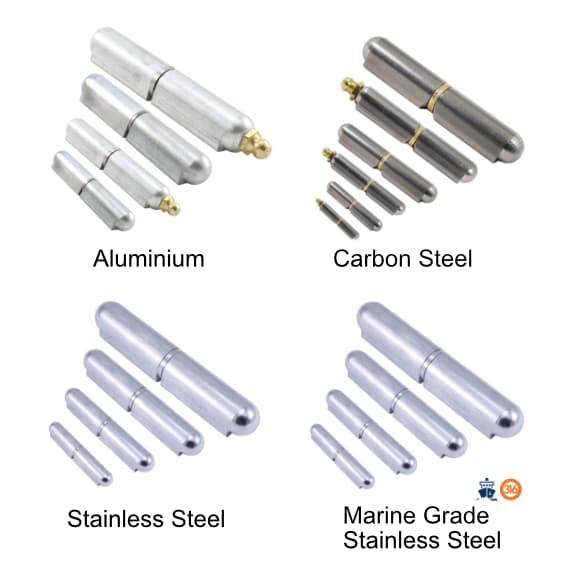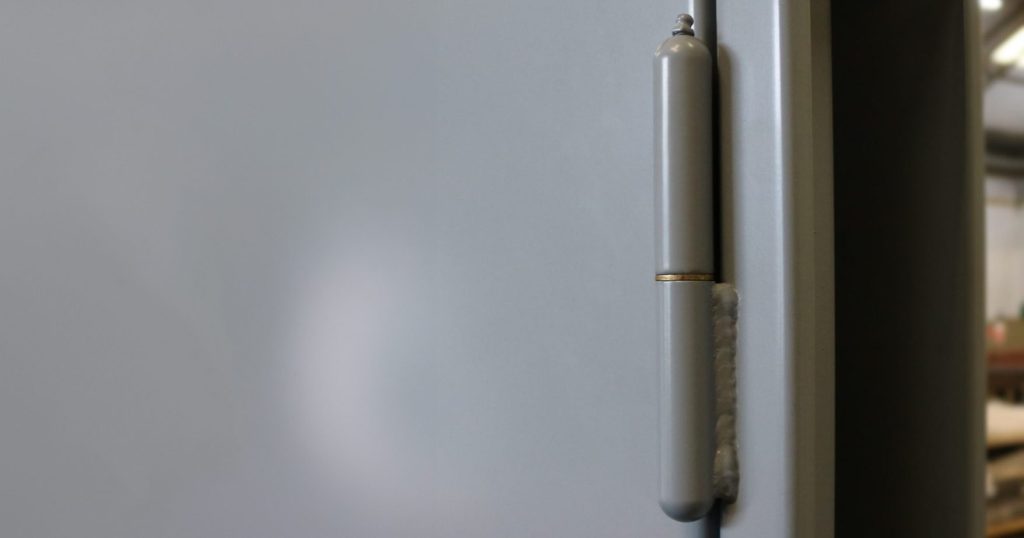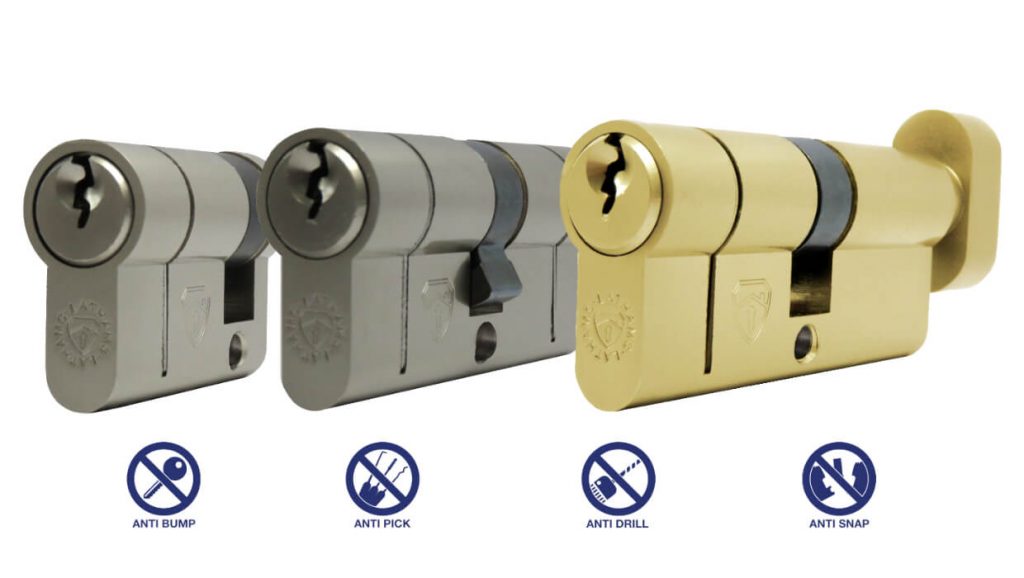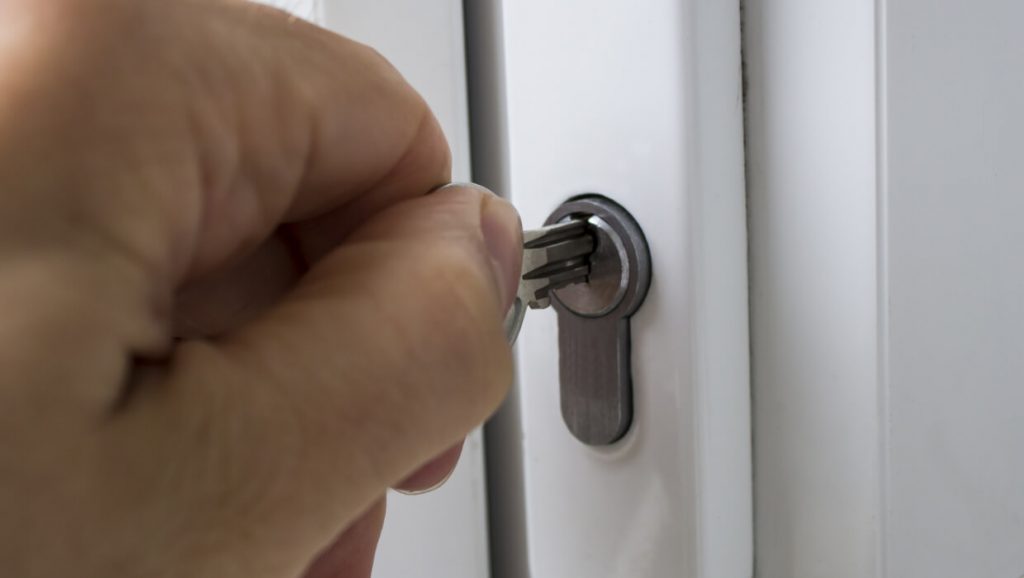A bullet hinge is a type of door hinge that plays an important role in our everyday lives. Although they are small and discreet, bullet hinges can provide doors with the support they need. Bullet hinges on exterior doors provide safety for your home and protection from the elements. Inside the home, they offer privacy for you and your loved ones.
- What are Bullet Hinges?
- How and When to Use a Bullet Hinge
- What are weld-on bullet hinges made of?
- What are the components that make up a bullet hinge?
- What Makes Bullet Hinges So Functional?
- The Best Materials for Bullet Hinges
- Butt Hinge
- Piano Hinge
- The T-hinge
- Which bullet hinge is right for your installation?
- Pros
- Cons
- How do you install bullet hinges?
- Maintenance
- FAQs
What are Bullet Hinges?
A bullet hinge is renowned for the strength and security it offers, compared to a more traditional hinge. The robust hinge is round, small, unobtrusive and designed to be discreet. However, it can support and withstand a substantial amount of weight.
Also known as a weld-on hinge, bullet hinges are welded to another metal surface. This is why they are most commonly used to attach metal doors to metal frames. In contrast, traditional hinges are bolted into place.
A bullet hinge consists of two cylindrical hinges that are connected by a metal bar. The hinges are inserted into holes in a door and frame. The metal bar is then inserted into the holes in the hinges.
Available in various types of materials and sizes, these versatile hinges, aptly named ‘bullet’ due to the bullet-like shape of its barrel, are ideal for applications where a small, discreet hinge is required.
This type of hinge is very durable and can withstand a lot of wear and tear. This makes bullet hinges ideal for use on heavy furniture and exterior doors. Bullet hinges are also referred to as weldable hinges, barrel hinges, or lift-off hinges.
Why are weld-on hinges also called bullet hinges?
Weld-on hinges are also referred to as bullet hinges due to the hinge’s barrel resembling the look of a bullet. However, it’s also how the hinge is fastened – by welding. This type of hinge is very strong and can hold a large amount of weight.
What is a Lift-Off Bullet Hinge?
A lift-off bullet hinge is a unique hinge that is designed to make it easy to lift heavy objects. The hinge has a bullet-shaped design that makes it easy to grip. It also has a spring-loaded mechanism that helps to lift the object quickly and easily.
Lift-off bullet hinges are made up of two parts, which allow you to remove the door without the need to open it. The unique hinge can also be installed with the top pin down to pincer the door or object from being removed. The hinge also provides a clean-looking finish.
How and When to Use a Bullet Hinge
Bullet hinges are a type of hinge that is designed for use in high-traffic areas. This is due to the hinge’s bullet-shaped profile, which allows for plenty of wear and tear, compared to traditional hinges.
A bullet hinge is a reliable method for attaching metal doors with metal frames and is commonly used in busy public spaces, such as schools, shopping centres, and hospitals. However, they are also used for domestic exterior and interior doors, providing extra durability and security for the home.
Bullet hinges come in a variety of sizes. Take a look at our size guide to direct you to the best bullet hinge for your application:
How do weld-on bullet hinges work?
Weld-on bullet hinges are durable and provide a high level of security. This is why they are popular for use in domestic applications, including gates, enclosures, cabinets, electrical items, and other household items. Weld-on bullet hinges provide a robust way to attach metal doors and frames to their metal doors.
What are weld-on bullet hinges made of?
Weld-on bullet hinges are available in a variety of materials, including stainless steel, aluminium, and carbon steel. The material used in a bullet hinge must be strong enough to withstand heavy loads.
Our weldable hinges are made from premium quality steel and Grade 304 Stainless Steel and Grade 316 Stainless Steel marine grade hinges. This makes them extra resistant to corrosion.
Grease fittings can be found on both stainless steel bullet hinges as well as aluminium bullet hinges. This allows the hinge pin to be easily lubricated, which is an ideal mechanism for heavy doors.
What are the components that make up a bullet hinge?
Bullet hinges or weld-on hinges consist of three main components; the leaf side (also known as female); the pin side (also known as male); and the brush that sits between the two halves.
The female barrels are welded onto the surface that needs to move, such as doors. Male barrels are welded to the structural elements.
What Makes Bullet Hinges So Functional?
A bullet hinge may be small in size and has a low profile, however, all these attributes make for a functional, robust and compact hinge.
Bullet hinges are known for their functionality, due to their ball-and-socket design. This allows them to rotate a full 360 degrees, providing a smooth and easy motion.
Providing versatility, a weld-on bullet hinge can be installed on any part of the product at hand and at any angle required. The hinge is a popular choice for a variety of applications, including furniture, store displays and cabinetry.
The Best Materials for Bullet Hinges
Choosing the right material for your bullet hinge can be a daunting task. Each material comes with its advantages and disadvantages. Here is a breakdown of the most common materials used for bullet hinges:

Carbon Steel bullet Hinges
Carbon steel bullet hinges are used to connect two pieces of metal, making them both strong and durable. Carbon steel is also resistant to corrosion, making it a sensible choice for outdoor applications. However, steel is also a heavy material, which can make it difficult to install and operate.
Aluminium Bullet Hinges
Aluminium is a lightweight alternative to steel, however, it still holds its own in strength and is resistant to corrosion. It is a good choice for applications where weight is a concern. On the downside, aluminium is not as durable as steel and can corrode over time.
Stainless Steel Bullet Hinges
If you’re looking to add a touch of style to your application, stainless steel will provide this. Not only does it have a sleek finish, but stainless steel also offers strength and durability. If corrosion resistance is important for your application, such as an exterior door, stainless steel is the ideal choice. However, stainless steel is heavier than its aluminium alternative and can be tricky to install and operate.
Marine Grade Stainless Steel
Marine-grade stainless steel is a type of steel that is specifically designed to resist corrosion in a saltwater environment. This type of steel is ideal for use in boats, docks, and other structures that are exposed to saltwater. Marine-grade stainless steel is also resistant to rust and other forms of corrosion. Discover our various types of bullet hinges: Bullet Hinges – Weld On Bullet Hinges | Latham’s Hardware (lathamshardware.co.uk)
Other hinges available on the market
If bullet hinges are not what you’re looking for, there are many different types of hinges available that will meet your requirements.
Butt Hinge
This is a type of surface mount hinge, which sits on top of the surface of the door material. A butt hinge is made of two mounting plates and a barrel held together by a hinge pin. A durable and reliable hinge option that is suitable for most types of door installations, including outside gates and cabinet doors.
Piano Hinge
This is a continuous hinge with a central pin and same-sized leaves that run the length of a door or box lid. Its name refers to the fact that the hinge is most commonly used on pianos. However, it can be used on many more applications, including desks, cabinet doors, work benches and storage boxes.
The T-hinge
Unsurprisingly, these hinges are shaped like the letter T. One of the leaves is longer and protrudes outward than the other leaf. Thanks to their unique shape, they can accommodate heavy loads, such as gates and garage doors.
Check out our variety of hinges available today: Door Hinges – Light & Heavy Duty | Latham’s Hardware (lathamshardware.co.uk)
Which bullet hinge is right for your installation?
There is a wide range of bullet hinges available on the market, so it can be difficult to decide which will meet your needs.
Some factors to consider include the weight of the door, the type of door, and the installation requirements. You also need to decide whether you want a traditional hinge or a hidden hinge. It’s also worth thinking about whether you will need to use a corrosion-resistant material, especially if it is an exterior door.
Pros and Cons of Bullet Hinges
To help you decide on the correct type of hinge for your installation, we have outlined the pros and cons of using a bullet hinge.
Pros
Cons
How do you install bullet hinges?
Installing a bullet hinge can be done with relative ease. The hinge can be installed anywhere you choose, at any angle required. The only necessity is that the metal surface supports welding. Bullet hinges cannot be installed on wood, therefore a more traditional hinge would work better on a wooden application.
As with any hinge, alignment is very critical. Bullet hinges are tight fitting so they must be aligned even more precisely.
If you have not welded before, you will need to learn about tack welding, which are small welds that temporarily bond metals. This enables you to maintain the joint gap while holding the hinge in place. This will also show you if the hinge is aligned and in place.
Tools you may need:
How to Install Bullet Hinges for Doors
Bullet hinges are a type of door hinge that is designed to be more resilient and stronger than traditional door hinges. They are made to withstand more wear and tear. Bullet hinges can be used in applications where a traditional hinge is not strong enough to support the weight of the door.
Here’s how to install a bullet hinge for a door:
How to Install Bullet Hinges for Cabinets
Here’s how to install bullet hinges for cabinets is a simple process that can be completed in just a few minutes. Before starting, It’s important to determine the size and number of bullet hinges you will need.
Here’s how to install bullet hinges for a cabinet:
How to Install Bullet Hinges for Metal Gates
Bullet hinges are ideal for metal gates as they need to be installed through welding. Installing hinges on a metal gate is a simple process.
Here’s how to install a bullet hinge for a metal gate:
Take a look at the gate hinges we have available.
Maintenance
How do you grease a bullet hinge?
There is nothing worse than a squeaky door, so bullet hinges must be maintained. Dirt and grime will build up within the hinge over time, wearing down the metal and making it sticky. To keep bullet hinges looking shiny and new, greasing a bullet hinge is the best technique to ensure their longevity.
Firstly, choose a lubricant. Lithium grease is effective and dust-resistant, whilst silicone spray lubricants are the easiest lubricants to use for greasing door hinges.
You will then need to remove any old grease or dirt from the hinge with a solvent. Next, apply a thin layer of grease to the hinge using a brush or your finger. Finally, wipe off any excess grease with a cloth.
FAQs
A barrel hinge is a type of hinge that is used to connect two pieces of wood and can hold up to a certain amount of weight. The amount of weight that a barrel hinge can hold depends on the size and strength of the hinge.
Barrel hinges are used for wood projects, such as small cabinets or jewellery boxes. They’re a great choice when you don’t want to see a hinge; barrel hinges are invisible from either side when looking at a wood box or cabinet. Barrel hinges aren’t recommended for vertical or load-bearing applications.
Adding bullet hinges on your doors will improve its functionality and appearance. By replacing traditional door hinges with bullet hinges, you are ensuring longevity and not having to maintain your doors time and time again with new hinges.





